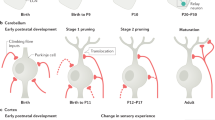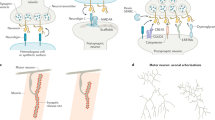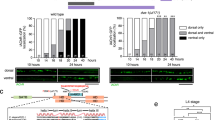Abstract
Neuronal activity regulates the development and maturation of excitatory and inhibitory synapses in the mammalian brain. Several recent studies have identified signalling networks within neurons that control excitatory synapse development. However, less is known about the molecular mechanisms that regulate the activity-dependent development of GABA (γ-aminobutyric acid)-releasing inhibitory synapses. Here we report the identification of a transcription factor, Npas4, that plays a role in the development of inhibitory synapses by regulating the expression of activity-dependent genes, which in turn control the number of GABA-releasing synapses that form on excitatory neurons. These findings demonstrate that the activity-dependent gene program regulates inhibitory synapse development, and suggest a new role for this program in controlling the homeostatic balance between synaptic excitation and inhibition.
This is a preview of subscription content, access via your institution
Access options
Subscribe to this journal
Receive 51 print issues and online access
$199.00 per year
only $3.90 per issue
Buy this article
- Purchase on Springer Link
- Instant access to full article PDF
Prices may be subject to local taxes which are calculated during checkout






Similar content being viewed by others
References
Katz, L. C. & Shatz, C. J. Synaptic activity and the construction of cortical circuits. Science 274, 1133–1138 (1996)
Spitzer, N. C. Electrical activity in early neuronal development. Nature 444, 707–712 (2006)
Wong, R. O. & Ghosh, A. Activity-dependent regulation of dendritic growth and patterning. Nature Rev. Neurosci. 3, 803–812 (2002)
Zito, K. & Svoboda, K. Activity-dependent synaptogenesis in the adult mammalian cortex. Neuron 35, 1015–1017 (2002)
Ben-Ari, Y. Excitatory actions of GABA during development: the nature of the nurture. Nature Rev. Neurosci. 3, 728–739 (2002)
Kenet, T., Froemke, R. C., Schreiner, C. E., Pessah, I. N. & Merzenich, M. M. Perinatal exposure to a noncoplanar polychlorinated biphenyl alters tonotopy, receptive fields, and plasticity in rat primary auditory cortex. Proc. Natl Acad. Sci. USA 104, 7646–7651 (2007)
Maffei, A., Nelson, S. B. & Turrigiano, G. G. Selective reconfiguration of layer 4 visual cortical circuitry by visual deprivation. Nature Neurosci. 7, 1353–1359 (2004)
Buschges, A. & Manira, A. E. Sensory pathways and their modulation in the control of locomotion. Curr. Opin. Neurobiol. 8, 733–739 (1998)
Brown, P., Ridding, M. C., Werhahn, K. J., Rothwell, J. C. & Marsden, C. D. Abnormalities of the balance between inhibition and excitation in the motor cortex of patients with cortical myoclonus. Brain 119, 309–317 (1996)
Cline, H. Synaptogenesis: a balancing act between excitation and inhibition. Curr. Biol. 15, R203–R205 (2005)
Mohler, H. GABAA receptors in central nervous system disease: anxiety, epilepsy, and insomnia. J. Recept. Signal Transduct. Res. 26, 731–740 (2006)
Rubenstein, J. L. & Merzenich, M. M. Model of autism: increased ratio of excitation/inhibition in key neural systems. Genes Brain Behav. 2, 255–267 (2003)
Wassef, A., Baker, J. & Kochan, L. D. GABA and schizophrenia: a review of basic science and clinical studies. J. Clin. Psychopharmacol. 23, 601–640 (2003)
Burrone, J., O’Byrne, M. & Murthy, V. N. Multiple forms of synaptic plasticity triggered by selective suppression of activity in individual neurons. Nature 420, 414–418 (2002)
Malinow, R. & Malenka, R. C. AMPA receptor trafficking and synaptic plasticity. Annu. Rev. Neurosci. 25, 103–126 (2002)
Turrigiano, G. G., Leslie, K. R., Desai, N. S., Rutherford, L. C. & Nelson, S. B. Activity-dependent scaling of quantal amplitude in neocortical neurons. Nature 391, 892–896 (1998)
Benevento, L. A., Bakkum, B. W. & Cohen, R. S. Gamma-aminobutyric acid and somatostatin immunoreactivity in the visual cortex of normal and dark-reared rats. Brain Res. 689, 172–182 (1995)
Chattopadhyaya, B. et al. Experience and activity-dependent maturation of perisomatic GABAergic innervation in primary visual cortex during a postnatal critical period. J. Neurosci. 24, 9598–9611 (2004)
Foeller, E. & Feldman, D. E. Synaptic basis for developmental plasticity in somatosensory cortex. Curr. Opin. Neurobiol. 14, 89–95 (2004)
Marty, S., Wehrle, R. & Sotelo, C. Neuronal activity and brain-derived neurotrophic factor regulate the density of inhibitory synapses in organotypic slice cultures of postnatal hippocampus. J. Neurosci. 20, 8087–8095 (2000)
Micheva, K. D. & Beaulieu, C. Development and plasticity of the inhibitory neocortical circuitry with an emphasis on the rodent barrel field cortex: a review. Can. J. Physiol. Pharmacol. 75, 470–478 (1997)
Seil, F. J. & Drake-Baumann, R. Activity-dependent changes in “transplanted” cerebellar cultures. Exp. Neurol. 138, 327–337 (1996)
Hensch, T. K. Critical period plasticity in local cortical circuits. Nature Rev. Neurosci. 6, 877–888 (2005)
Turrigiano, G. G. & Nelson, S. B. Homeostatic plasticity in the developing nervous system. Nature Rev. Neurosci. 5, 97–107 (2004)
Benson, D. L. & Cohen, P. A. Activity-independent segregation of excitatory and inhibitory synaptic terminals in cultured hippocampal neurons. J. Neurosci. 16, 6424–6432 (1996)
Nedivi, E., Hevroni, D., Naot, D., Israeli, D. & Citri, Y. Numerous candidate plasticity-related genes revealed by differential cDNA cloning. Nature 363, 718–722 (1993)
Worley, P. F., Cole, A. J., Saffen, D. W. & Baraban, J. M. Regulation of immediate early genes in brain: role of NMDA receptor activation. Prog. Brain Res. 86, 277–285 (1990)
Ooe, N., Saito, K., Mikami, N., Nakatuka, I. & Kaneko, H. Identification of a novel basic helix-loop-helix-PAS factor, NXF, reveals a Sim2 competitive, positive regulatory role in dendritic-cytoskeleton modulator drebrin gene expression. Mol. Cell. Biol. 24, 608–616 (2004)
Flood, W. D., Moyer, R. W., Tsykin, A., Sutherland, G. R. & Koblar, S. A. Nxf and Fbxo33: novel seizure-responsive genes in mice. Eur. J. Neurosci. 20, 1819–1826 (2004)
Hester, I. et al. Transient expression of Nxf, a bHLH-PAS transactivator induced by neuronal preconditioning, confers neuroprotection in cultured cells. Brain Res. 1135, 1–11 (2007)
Shamloo, M. et al. Npas4, a novel helix-loop-helix PAS domain protein, is regulated in response to cerebral ischemia. Eur. J. Neurosci. 24, 2705–2720 (2006)
Fletcher, T. L., Cameron, P., De Camilli, P. & Banker, G. The distribution of synapsin I and synaptophysin in hippocampal neurons developing in culture. J. Neurosci. 11, 1617–1626 (1991)
Huang, Z. J., Di Cristo, G. & Ango, F. Development of GABA innervation in the cerebral and cerebellar cortices. Nature Rev. Neurosci. 8, 673–686 (2007)
Gomeza, J. et al. Deletion of the mouse glycine transporter 2 results in a hyperekplexia phenotype and postnatal lethality. Neuron 40, 797–806 (2003)
Kash, S. F. et al. Epilepsy in mice deficient in the 65-kDa isoform of glutamic acid decarboxylase. Proc. Natl Acad. Sci. USA 94, 14060–14065 (1997)
Kash, S. F., Tecott, L. H., Hodge, C. & Baekkeskov, S. Increased anxiety and altered responses to anxiolytics in mice deficient in the 65-kDa isoform of glutamic acid decarboxylase. Proc. Natl Acad. Sci. USA 96, 1698–1703 (1999)
Huang, Z. J. et al. BDNF regulates the maturation of inhibition and the critical period of plasticity in mouse visual cortex. Cell 98, 739–755 (1999)
Rutherford, L. C., DeWan, A., Lauer, H. M. & Turrigiano, G. G. Brain-derived neurotrophic factor mediates the activity-dependent regulation of inhibition in neocortical cultures. J. Neurosci. 17, 4527–4535 (1997)
Seil, F. J. & Drake-Baumann, R. TrkB receptor ligands promote activity-dependent inhibitory synaptogenesis. J. Neurosci. 20, 5367–5373 (2000)
Aid, T., Kazantseva, A., Piirsoo, M., Palm, K. & Timmusk, T. Mouse and rat BDNF gene structure and expression revisited. J. Neurosci. Res. 85, 525–535 (2007)
Liu, Q. R. et al. Rodent BDNF genes, novel promoters, novel splice variants, and regulation by cocaine. Brain Res. 1067, 1–12 (2006)
Tao, X., Finkbeiner, S., Arnold, D. B., Shaywitz, A. J. & Greenberg, M. E. Ca2+ influx regulates BDNF transcription by a CREB family transcription factor-dependent mechanism. Neuron 20, 709–726 (1998)
Zhou, P. et al. Polarized signaling endosomes coordinate BDNF-induced chemotaxis of cerebellar precursors. Neuron 55, 53–68 (2007)
Kohara, K. et al. A local reduction in cortical GABAergic synapses after a loss of endogenous brain-derived neurotrophic factor, as revealed by single-cell gene knock-out method. J. Neurosci. 27, 7234–7244 (2007)
Chubykin, A. A. et al. Activity-dependent validation of excitatory versus inhibitory synapses by neuroligin-1 versus neuroligin-2. Neuron 54, 919–931 (2007)
Xia, Z., Dudek, H., Miranti, C. K. & Greenberg, M. E. Calcium influx via the NMDA receptor induces immediate early gene transcription by a MAP kinase/ERK-dependent mechanism. J. Neurosci. 16, 5425–5436 (1996)
Paradis, S. et al. An RNAi-based approach identifies molecules required for glutamatergic and GABAergic synapse development. Neuron 53, 217–232 (2007)
Stoppini, L., Buchs, P. A. & Muller, D. A simple method for organotypic cultures of nervous tissue. J. Neurosci. Methods 37, 173–182 (1991)
Li, C. & Wong, W. H. Model-based analysis of oligonucleotide arrays: expression index computation and outlier detection. Proc. Natl Acad. Sci. USA 98, 31–36 (2001)
Flavell, S. W. et al. Activity-dependent regulation of MEF2 transcription factors suppresses excitatory synapse number. Science 311, 1008–1012 (2006)
Acknowledgements
We thank members of the Greenberg laboratory for suggestions; S. Paradis, J. M. Gray, S. S. Margolis, J. Zieg and C. M. Fletcher for reading the manuscript; S. Vasquez for preparing primary neuronal cell cultures; M. Thompson, Y. Zhou and H. Ye for assistance in generating Npas4-/- mice; T. Diefenbach and the Neurobiology Program Imaging Center for assistance with confocal microscopy; M. Fagiolini for help with dissection of the visual cortex; and X. J. Liu and C. Chen for help with electrophysiology. M.E.G. acknowledges the generous support of the F. M. Kirby Foundation to the Neurobiology Program of the Children’s Hospital and support from the Nancy Lurie Marks Family Foundation. This work was supported by a Lefler Foundation postdoctoral fellowship (Y.L.), a Ruth L. Kirschstein National Research Service Award and a Helen Hay Whitney postdoctoral fellowship (B.L.B.), a National Science Foundation Graduate Research Fellowship (A.D.L.), the Jane Coffin Childs Memorial Fund (T.-K.K.) and Mental Retardation Research Center grant HD18655 and National Institutes of Health grants NS27572 and NS48276 (M.E.G.).
Author Contributions Y.L. and M.E.G. conceived and designed the experiments and wrote the manuscript. Y.L. performed or participated in each of the experiments described in the manuscript. B.L.B. performed the electrophysiological recordings and contributed to the writing of the manuscript. J.L.H. quantified Npas4 mRNA levels for the light stimulation experiment, generated the Npas4-minigene construct and performed the luciferase assay to characterize it, managed the Npas4 animal colony and provided extensive technical support. A.D.L. performed immunocytochemistry for the light stimulation experiment and confocal imaging of neurons in the synapse assay with Npas4-RNAi. A.C.K. provided technical support during the early phase of the study and helped generate many reagents used in this study including the Npas4 antibody, Npas4 knockout construct and Npas4-RNAi lentivirus. T.-K.K. performed the chromatin immunoprecipitation experiments. L.S.H. helped generate the Npas4 antibody. A.N.M. performed the initial chromatin immunoprecipitation experiments.
Author information
Authors and Affiliations
Corresponding author
Supplementary information
Supplementary Information
This file contains Supplementary Figures 1-7 with Legends and the Supplementary List. (PDF 6275 kb)
Rights and permissions
About this article
Cite this article
Lin, Y., Bloodgood, B., Hauser, J. et al. Activity-dependent regulation of inhibitory synapse development by Npas4. Nature 455, 1198–1204 (2008). https://doi.org/10.1038/nature07319
Received:
Accepted:
Published:
Issue Date:
DOI: https://doi.org/10.1038/nature07319
This article is cited by
-
Biphasic Npas4 expression promotes inhibitory plasticity and suppression of fear memory consolidation in mice
Molecular Psychiatry (2024)
-
Drosophila motor neuron boutons remodel through membrane blebbing coupled with muscle contraction
Nature Communications (2023)
-
Training-induced circuit-specific excitatory synaptogenesis in mice is required for effort control
Nature Communications (2023)
-
Excitation–transcription coupling, neuronal gene expression and synaptic plasticity
Nature Reviews Neuroscience (2023)
-
Downregulated NPAS4 in multiple brain regions is associated with major depressive disorder
Scientific Reports (2023)
Comments
By submitting a comment you agree to abide by our Terms and Community Guidelines. If you find something abusive or that does not comply with our terms or guidelines please flag it as inappropriate.



